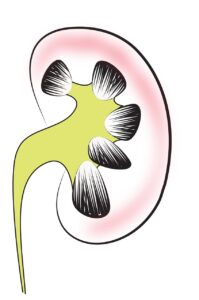Primary Hyperoxaluria Type 2 (PH2)
What is primary hyperoxaluria type 2?
Primary hyperoxaluria type 2 (PH2) is a rare condition that is characterized by the overproduction and excess of oxalate. Oxalate accumulates in the kidneys, where it combines with calcium to form the major substance that comprises kidney stones. The stones then lead to kidney damage or failure, and they can impact other organs as well. PH2 is less severe than primary hyperoxaluria type 1.
What are the symptoms of primary hyperoxaluria type 2?
The major signs of this condition are deposits of calcium oxalate in the kidney tissue, urinary tract, and kidney tract. Primary hyperoxaluria type 2 also leads to end-stage renal disease, which is followed by deposits of calcium oxalate throughout the body tissue. Other symptoms of this condition are caused by kidney stones. They include hematuria, obstruction of the urinary tract, and renal colic.
What causes primary hyperoxaluria type 2?
Mutations in the GRHPR gene cause this condition, and more than a dozen different alterations have been discovered. They are inherited in an autosomal recessive pattern. The commonality between these mutations is that they impact the glyoxylate reductase/hydroxypyruvate reductase enzyme, either by altering its production or its structure. Because of this, the enzyme is unable to break down glyoxylate, which then converts to oxalate.
How is primary hyperoxaluria type 2 diagnosed?
Doctors will look at a patient’s medical history, perform a clinical evaluation, and search for the characteristic symptoms of PH2. They will use various tests to diagnose this condition, such as imaging tests, blood tests, and a kidney biopsy. Genetic testing can be used to confirm a diagnosis.
What are the treatments for primary hyperoxaluria type 2?
Doctors will treat this condition by recommending a high intake of fluids, medications that stop calcium oxalate from crystallizing, and dialysis. The last step of treatment is a kidney transplant, which results in various levels of success. There is a risk of recurrence.
Where can I find out more about primary hyperoxaluria type 2?
PH2 Articles

Pivotal Phase 3 Study on Primary Hyperoxaluria Has High Quality Results


An Experimental Treatment for Primary Hyperoxaluria has Earned Rare Pediatric Disease Designation







